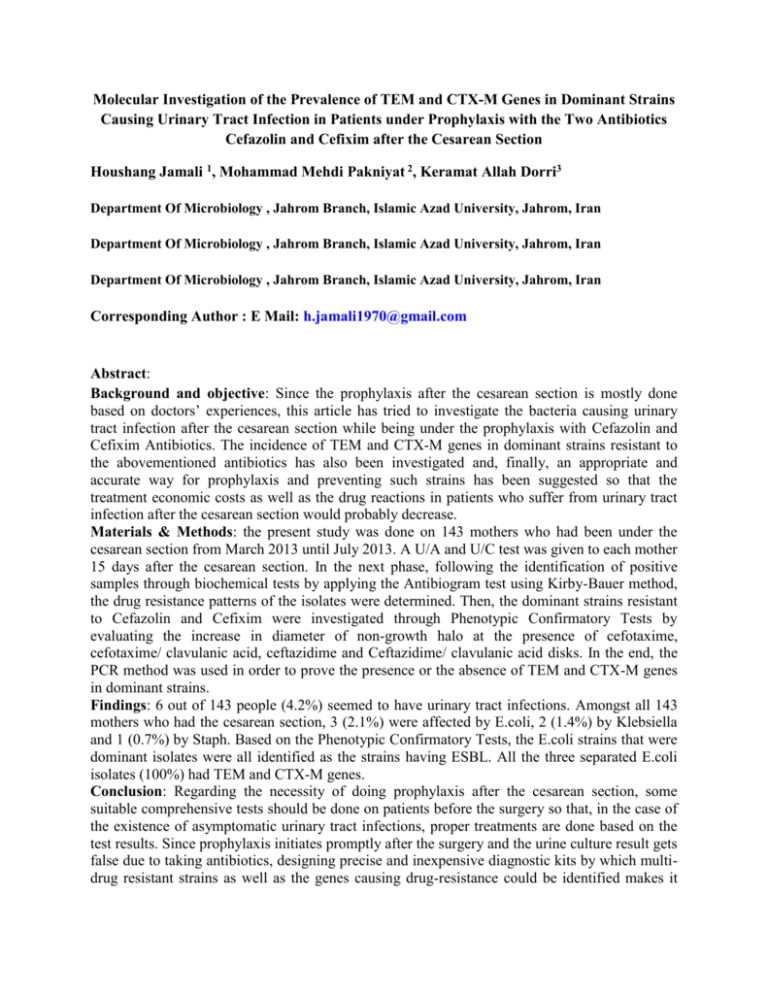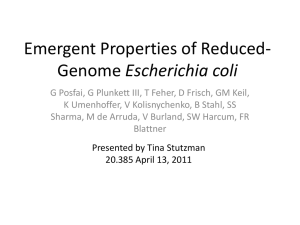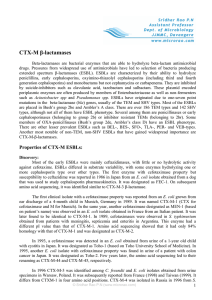Dr houshang jamali pakniyat
advertisement

Molecular Investigation of the Prevalence of TEM and CTX-M Genes in Dominant Strains Causing Urinary Tract Infection in Patients under Prophylaxis with the Two Antibiotics Cefazolin and Cefixim after the Cesarean Section Houshang Jamali 1, Mohammad Mehdi Pakniyat 2, Keramat Allah Dorri3 Department Of Microbiology , Jahrom Branch, Islamic Azad University, Jahrom, Iran Department Of Microbiology , Jahrom Branch, Islamic Azad University, Jahrom, Iran Department Of Microbiology , Jahrom Branch, Islamic Azad University, Jahrom, Iran Corresponding Author : E Mail: h.jamali1970@gmail.com Abstract: Background and objective: Since the prophylaxis after the cesarean section is mostly done based on doctors’ experiences, this article has tried to investigate the bacteria causing urinary tract infection after the cesarean section while being under the prophylaxis with Cefazolin and Cefixim Antibiotics. The incidence of TEM and CTX-M genes in dominant strains resistant to the abovementioned antibiotics has also been investigated and, finally, an appropriate and accurate way for prophylaxis and preventing such strains has been suggested so that the treatment economic costs as well as the drug reactions in patients who suffer from urinary tract infection after the cesarean section would probably decrease. Materials & Methods: the present study was done on 143 mothers who had been under the cesarean section from March 2013 until July 2013. A U/A and U/C test was given to each mother 15 days after the cesarean section. In the next phase, following the identification of positive samples through biochemical tests by applying the Antibiogram test using Kirby-Bauer method, the drug resistance patterns of the isolates were determined. Then, the dominant strains resistant to Cefazolin and Cefixim were investigated through Phenotypic Confirmatory Tests by evaluating the increase in diameter of non-growth halo at the presence of cefotaxime, cefotaxime/ clavulanic acid, ceftazidime and Ceftazidime/ clavulanic acid disks. In the end, the PCR method was used in order to prove the presence or the absence of TEM and CTX-M genes in dominant strains. Findings: 6 out of 143 people (4.2%) seemed to have urinary tract infections. Amongst all 143 mothers who had the cesarean section, 3 (2.1%) were affected by E.coli, 2 (1.4%) by Klebsiella and 1 (0.7%) by Staph. Based on the Phenotypic Confirmatory Tests, the E.coli strains that were dominant isolates were all identified as the strains having ESBL. All the three separated E.coli isolates (100%) had TEM and CTX-M genes. Conclusion: Regarding the necessity of doing prophylaxis after the cesarean section, some suitable comprehensive tests should be done on patients before the surgery so that, in the case of the existence of asymptomatic urinary tract infections, proper treatments are done based on the test results. Since prophylaxis initiates promptly after the surgery and the urine culture result gets false due to taking antibiotics, designing precise and inexpensive diagnostic kits by which multidrug resistant strains as well as the genes causing drug-resistance could be identified makes it possible to do some tests within a week after the surgery so that the necessary actions are immediately taken by the doctors in case the patients have been affected by multi-drug resistant hospital infections during and after being hospitalized. Keywords: cesarean section; urinary tract infection; bacterium; antibiotic resistance; ESBLs Introduction One of the complications that might threaten the mother’s life after the cesarean section is the urinary tract infections after the surgery [1]. The prevalence of drug-resistant bacteria allows every kind of infection to threaten the mother’s life after the cesarean section. For this reason, American College of Obstetricians and Gynecologists (2003) recommends pre-surgery (in high risk groups) as well as post-surgery (in both high-risk and low-risk groups) prophylaxis [2] but the main problem is that while these antibiotics are prescribed for prophylaxis, if some day in early future the multi-drug resistant bacteria spread in society, how can we save the mothers’ lives against death? In this study efforts have been done to evaluate the prevalence of TEM and CTX-M genes in dominant bacterial strains causing urinary tract infections in women under the prophylaxis with the two antibiotics Cefazolin and Cefixim after the cesarean section in order to suggest an appropriate way for prophylaxis preventing high treatment costs, increased adverse drug reaction, and production of drug-resistant strains. As far as drug-resistance is concerned, the new topic that is being discussed recently is the existence of the strains with extendedspectrum beta-lactamase enzymes whose spread in hospitals can cause a real disaster. One of these beta-lactamase enzymes is the ESBLs that are especially important in antimicrobial therapy. These enzymes are able to completely hydrolyze Oximino βlactams which are available in the structure of third generation of Cephalosporins. The enzymes were first detected in 1980s and were mostly SHV and TEM types. The CTX-M family of ESBLs was first reported in 1989 in Germany and, afterwards, spread worldwide [3, 4 & 5]. Methodology In this research, during 3 months (March 21st until June 22nd, 2013) 143 cesarean sectioned mothers in a hospital in Fars province were examined regarding urinary tract infections. Following the coordination with the doctors and personnel of Women Department, Surgery Section, the patients were prescribed a U/A and U/C test to be done 15 days after the surgery; it was 3 days after the end of prophylaxis period by Cefazolin (during 2 days of being hospitalized) and Cefixim (for 10 days after getting discharged) to prevent urine culture false result. The sterile morning median urine was collected from the patients in the laboratory and in less than 20 minutes, the cultures were prepared from urine samples using the standard method on EMB Differential and Blood Agar Media. Then the media were placed in an incubator of 37°c for 24 to 48 hours so that if there were any infections, the number of colonies gets sufficient. After that, the colonies were investigated through SIM, TSI, urease, Simmons Citrate, Methyl red, VP, DNase, and Catalase tests in order to identify the bacteria types. In the meantime, the growth of more than 3 types of colonies in the media was reported as the pollution, and the test was repeated. While doing diagnostic tests, the Antibiogram test was also applied to the bacteria and then the separated isolates were stored in Skim milk broth medium at -70°c so that these strains could be used in the next phases. For doing the Antibiogram test, the Disk agar diffusion method based on CLSI instruction as well as the Cefixime (5µg), Cefazolin (30µg), Nalidixic acid (30µg ), Gentamicin (10µg)( ، Nitrofurantion (300µg), Ciprofloxacin (5µg), Co trimoxazole (1.25µg), Ceftriaxone (30µg) and Cefalexin ( 30 µg ) antibiotic disks were used. Meanwhile, 6 isolates were separated, 3 of which were E.coli, 2 of them were Klebsiella and one was Staph. In the next step, following the instructions of CLSI World Organization, the Phenotypic Confirmatory Tests were applied to the dominant strains, i.e. E.coli, using combined disk. For this purpose, first the E.coli microbial suspension was prepared based on 0.5 McFarland concentrations and was completely distributed in Mueller-Hinton agar plate. After that, the antibiotic disks Cefotaxime (30 µg), Cefotaxime + Clavulanate (30-10 µg), Ceftazidime (30 µg) and Ceftazidime + Clavulanate (30-10 µg) were placed on the plate with the distance of at list 2.5cm from each other. In the last phase, the samples which had been incubated for 24 hours at the temperature of 37°c, formed non-growth halo of 5mm or more around the disks having Clavulanate and were investigated in comparison with those without Clavulanate. The result of this test was positive for all three samples (figure 1). Figure 1: the Phenotypic Confirmatory Tests in E.coli isolates Finally, the PCR tests were used to prove the existence of CTX-M and TEM genes in E.coli isolates. The tests’ procedures were as follows: First, a culture from the samples stored in Skim milk broth medium was prepared in Mueller-Hinton agar plate, and the samples were placed in a 37-degree incubator for 24 hours. Then the boiling method was used for the separation and purification of DNA. In this method 3 bacterial colonies were solved in 500 micro-liters sterile distilled water inside a micro tube. Next, the sample was boiled in 100°c for 15 minutes and it was centrifuged at the speed of 14000 rpm for 10 minutes. In the end, the PCR test was conducted to detect CTX-M (550 bp) and TEM (847 bp) genes. The PCR reaction at 25 micro liters final volume was done as follows: 50 millimolar TrisHcl, 50 millimolar kcl, 0.2 millimolar dNTP, 10 picomoll of each primer, 200 nanogram model DNA according to the provided time and temperature conditions of the thermal cycler. The primer sequences were as follows, respectively: The PCR products were electroforezed to determine the existence of CTX-M and TEM genes in Agarose Gel 2%. In all stages, Klebsiella pneumoniae ATCC 700603 and E.coli ATCC 25922 strains were used as positive control and negative control, respectively. In the end, all obtained information was analyzed by SPSS (version 20). CTX-M – F 5΄ TTTGCGATGCATACCAGTAA – 3΄ , CTX-M – B 5΄ - CGATATCGTTGGTGGTGCCAT - 3΄ , TEM – F 5΄ - ATG AGTATT CAA CAT TTC CG – 3΄ & TEM – B - 5΄ - CTG ACA GTT ACC AAT GCTTA – 3΄ The molecular weight for CTX-M segment was 550 bp while it was 847 bp for TEM segment [6 & 7]. Besides, the time and temperature conditions used for different stages of PCR on CTX-M and TEM genes were as follows, respectively: 1) The Initial Denaturation stage for both genes was 94°c, but the necessary times for CTX-M and TEM in this stage were 4min and 5 min, respectively. 2) The Denaturation stage for both genes was94°c; also the necessary time for both was 1 min. 3)The Annealing stage for CTX-M was conducted at 60°c in 0.5 min, while it was conducted at 61°c in 1 min for TEM. 4) The Extension stage for both genes lasted 1 min at 72°c. 5) The Final Extension stage for both genes lasted 5 min at 72°c. The number of rounds in the cycle was 35. Findings: Among the 143 mothers who referred to the laboratory 15 days after the cesarean section, 6 people (4.2%) got infected to urinary tract infection, although they were under prophylaxis by Cefazoline and Cefixime. 3 of those 6 mothers (2.1%) had been infected to E.coli, 2 (1.4%) to Klebsiella, and 1 (0.7%) to Staph (table 1). Table 1: Frequency distribution of the number and percentage of separated isolates among all people referred to the library Bacteria name E.coli Klebsiella Staph No growth Total nomber 3 2 1 137 143 percentage 2.1 1.4 0.7 95.8 100 The frequency of isolates among the 6 patients conforms to chart 1. Table 2: the number and percentage of the patients’ age Patients’ age 21 27 29 32 37 Staph 16.7% Klebsiella 33.3% E.coli 50% Chart 1: The frequency of separated isolates In addition, the degree of antibiotics resistance among separated isolates is shown in chart 2. number 1 1 2 1 1 percentage 16.7 16.7 33.3 16.7 16.7 Finally, the PCR test was done in order to detect the CTX-M and TEM genes on Escherichia coli isolates separated from the patients after the confirmatory test for the existence of ESBL genes and the following results were obtained: the resistance of the isolates 120 100 80 60 E.coli 40 Klebsiella 20 Staph 0 antibiotic type Chart 2: the resistance of the isolates to the used antibiotics According to chart 2, among the 3 separated isolates the most amount of antibiotic resistance is against Cefixim, Cefazoli, Cefalexin and Ceftriaxone, averagely (R=100%), while the least resistance is against Nitrofurantion (R=33.3%). The other point is the age of the infected mothers. The average age of the patients was 29.2 and the percentage of age frequency of the patients was obtained according to table 2. Figure 3: the PCR results for E.coli isolate 1: M marker – numbers 1 and 3 are positive control for TEM and CTX-M genes, respectively - Numbers 2 and 4 are for TEM and CTX-M genes under study in the sample Table 3: the prevalence percentage of ESBL in E,coli isolates strain Percentage of CTX-M presence in the isolate Percentage of TEM presence in the isolate E.coli 1 E.coli 2 E.coli 3 100 100 100 100 100 100 Table 3 shows that all three E.coli isolates have 100% CTX-M and TEM genes and it is not a good signal for us because the prevalence of these two genes in the bacteria makes almost all antibiotics of cephalosporin group ineffective on these strains. If we turn back again and this time evaluate the antibiotic resistance in just E.coli isolate, we will see that the most resistance in E.coli isolate is to Cefixim, Cefazolin, Cefalexin, Ceftriaxone and Co-trimoxazole to 100% amount which, with regard to the betalactamase genes available in them, is not unexpectable. But they have no resistance against Nitrofurantion and it can be the best choice for prophylaxis for urinary tract infections after the cesarean section; their resistance against Gentamicin and Ciprofloxacin (33.3%) is low, though. Regarding Nalidixic acid it can be said that it is not a suitable drug for these strains any more since the resistance against this antibiotic has increased, too. Table 4: the beta-lactamase genes in E.coli isolates and the antibiotic resistance model TEM CTX-M strain E.coli + + 1 E.coli + + 2 E.coli + + 3 The name of the antibiotics against which there has appeared some resistance ، Cefazolin ، Cefixime ، Gentamicin ، Cefalexin Co - trimoxazole ، Ceftriaxone Cefalexin ، Cefazolin ،Cefixime ، Nalidixic acid ، Ceftriaxone، Co - trimoxazole ، Ciprofloxacin Cefalexin ، Cefazolin ،Cefixime Nalidixic acid ، Ceftriaxone ، Co - trimoxazole ، By looking at the above table, we understand that although there are both CTX-M and TEM genes in all strains, these genes do not have exactly the same antibiotic resistance pattern, and this can be justified as follows: these strains have received different subcategories of these two genes. As mentioned before, the products of CTXM and TEM genes can open the beta-lactam circle and remove the antimicrobial effect of the antibiotics of the cephalosporin group. It is worth considering that prescribing antibiotics without doing Antibiogram test causes the formation of multi-drug resistant strains which, in case they increase in hospitals, they can make a serious problem for the treatment of hospital infections and in addition to imposing high economical costs on patients, they also make drug reactions caused by taking too much antibiotics to treat the infection in the patients. Discussion: The beta-lactamase genes, especially ESBLs, in bacteria are an important factor in making resistance against Cephalosporins, and the organisms carrying these factors would cause the increased pathogenecity and death risk among patients. If this trend is not controlled, it makes a serious problem in the society [8 & 9]. The amount of ESBLs production among the bacteria of Entrobacteriaceae family is different around the world [10]. The question is that if these bacteria spread in hospitals, how can we save the lives of those who have been under the operation? In the present study that was done on 143 mothers who had been under the cesarean section, 6 mothers (4.2%) got infected by the urinary tract infection after the surgery. Amongst them, 3 people (50%) had E.coli, 2 (33.3%) had Klebsiella and 1 (16.7%) had Staph. Regarding the reasons for the infections caused in the hospital under study, the followings can be mentioned: using catheters, the weakness of the immune system, high bleeding during and after the surgery, the poor level of hygiene in hospital rooms’ toilets, the neighboring of surgery rooms to emergency departments, lack of suitable ventilation system in hospitals, different people moving through the department of nursing after the surgery, misuse of prescribed antibiotics by patients during the hospitalizing period and after leaving the hospital. Bacteria name number percentage The number of infected people People resistant to Cefixime number percentage Another study, titled as an investigation of the effect of Intravenous cephazolin on infectious complications after low-risk cesarean section which was done on 257 patients in Shahid Mostafa Khomeini and Hazrat Zeinab hospitals in Tehran, the amount of urinary tract infections in the group that received Cephazolin was 1.6% and in the group that did not receive it was 3.1%. As the separated strains in these studies were Cephazolin resistant, our results conformed to those who did not receive Cephazolin [12]. Table 6: drug resistance to Cefixim and Cephazolin in the study by Shirazi et al (2007) People resistant to Cefazolin According to a research in a hospital in east of India, 75 cesarean sectioned mothers under various prophylaxis after the surgery in order to prevent the post-surgery infections were studied and it was seen that 13% of these people had post-surgery urinary tract infections. It should be noted that drug regimens other than Cefazolin and Cefixim were used as prophylaxis in that hospital and the cause of these infections were the bacteria Escherichia coli 50%, Klebsiella 25% and Pseudomonas 25% [11]. It should be noted that non-diagnostic urinary tract infections in pregnant women can also originate post-cesarean infections. In a study by Shirazi et al (2007) on 377 pregnant women, the amount of nondiagnostic urinary tract infections caused by Cefixim and Cephazolin resistant E.coli and Klebsiella pneumonia in pregnant women was reported as in table 6. 53.8 14 42.6 12 26 E.coli 33.3 1 0 0 3 K.pneumoniae As can be seen, among the separated samples, Cefixim and Cephazolin resistant isolates are seen and if doctors prescribe Cefixim and Cephazolin to prevent the infections without giving the Antibiogram test after the cesarean section, no prevention will be done in these people. But in the present study, the E.coli bacterium was the dominant isolate taken away from patients which conformed to other studies on urinary tract infections. For instance, according to Parveen et al (2011), the amount of urinary tract infections by E,coli during pregnancy was 88.15%; according to Okonko et al, (2010) the frequency of E.colis was 42.1% while in the studies by Saraswathi & Aljabri (2013) this frequency was reported 66.67%. But one issue that is recently discussed about drug-resistance is the appearance of ESBL strains. These strains have various drug-resistant genes including CTX-M, TEM and SHV [3 & 17]. In the present study all three strains were 100% ESBL type, and since this study was done in Fars province, the results conformed to the results of the studies by Shacheraghi et al (2011) regarding the existence of ESBL strains in Fars province. According to the reported statistics from other parts of the world, the frequency of E.coli strains producing ESBL was as follows: in Bangladesh 43.2% in 2004, in Germany 10.3% in 2003, in Turkey 17% in 2004and in Palestine 22% in 2005 [19]. If we do a comparison between the strains receiving CTX-M gene in this study with other parts of the world, we will see that from the year 2005 onward the frequency of the strains having CTX-M gets more. According to the reported statistics about the ESBL genes, the frequency of the strains resistant to antibiotics having CTX-M betalactamase genes has increased from 26.6% in 2007 to 43.8% in 2010 [20], or the prevalence of these strains in Korea’s hospitals in 2005 has been 84.3% and in Brazil it has been 61.1% in 2008 [21 & 22]. Conclusion: Regarding the necessity of prophylaxis after the cesarean section, a series of suitable, comprehensive tests should be done on patients before the surgery to do the correct treatments based on the test results in case there is an infection. Since the prophylaxis starts promptly after the surgery and the culture result gets false due to taking antibiotics, designing precise and inexpensive diagnostic kits by which multidrug resistant strains as well as the genes causing drug-resistance could be detected makes it possible to do some tests within a week after the surgery so that the necessary actions are immediately taken by the doctors in case the patients have been affected by multi-drug resistant hospital infections during and after being hospitalized. Acknowledgement: Hereby we sincerely appreciate all people who helped us in conducting this research, especially Mr. Pirouzi. References: 1.Scott JR, Disaia PJ. Danforth ’s obstetrics and gynecology. 6th ed. Philadelphia, lippincott. company 1990; pp: 639 – 57. 2. Katynghm, f. , Levuno, k. , Bloom, S. , House, g. , Ross, d. , Sponge, k. ,( 2008 ) , Translator: Ghazi gahani, b And ghotbi. , 1389, Williams pregnancy. Tehran: Golban Nashre , Vol. 1 , pp: 838 - 839. 3. Sharifi Yazdi, M.K. and Soltan Dallal, M.M. , 2013 , Prevalence study of enterococus and staphylococci resistance to vancomycin isolated from urinary tract infections , Iran University Medical Journal. , 71(4) , pp. 250 – 258 . 4. Tzouvelekis, L.S. , Tzelepi, E. , Tassios, P.T. , Legakis, N.J. , 2000 , CTX-M-type beta-lactamases: an emerging group of extended-spectrum enzymes , Int J Antimicrob Agents. , 14(2) , pp. 137 142 . 5.Taslima, Y. , 2012 , Prevalence of ESBL among Esch. coli and Klebsiella spp. in a tertiary care hospital and molecular detection of important ESBL producing genes by multiplex PCR , Department of Microbiology & Immunology Mymensingh Medical College Mymensingh. 6. Sidjabat, H.E. , Paterson, D.L. , Adams – Haduch, J.M. , Ewan, L. , Pasculle, A.W. , Muto, C.A. , Tian, G.B. , Doi, Y. , 2009 , Molecular Epidemiology of CTX-MProducing Escherichia coli Isolates at a Tertiary Medical Center in Western Pennsylvania , Antimicrob Agents Chemother. , 53(11) , pp. 4733 – 4739 . 7. Omar, B.A. , Alfadel, O.O. , Atif, H.A. , Mogahid, M.E. , 2013 , Prevalence of TEM, SHV and CTX-M genes in Escherichia coli and Klebsiella spp Urinary Isolates from Sudan with confirmed ESBL phenotype , Life Science Journal. , 10(2) , pp. 191-195 . 8. Poirel L, Weldhagen GF ,Naas T ,De Champs C, Dove MG12-, Nordmann P. GES-2, a class A beta-lactamase from Pseudomonas aeruginosa with increased hydrolysis of imipenem. Antimicrob Agents Chemother. 2001; 45(9):2598603. 9.Parveen, K. , Momen, A. , Begum, A.A. , Begum, M. , 2011 , Prevalence Of Urinary Tract Infection During Pregnancy , Journal Dhaka National Med. , 17(2) , pp. 8 – 12 . 10.Falagas ME, Karageorgopoulos DE. Extended-spectrum betalactamase - producing organisms. J Hosp Infect 2009;73(4):345-54. 11.Heethal, J. , Sarala, N. , Kumar, T.N. , Hemalatha, M. , 2010 , Pattern of antimicrobial use in caesarean section in a tertiary care hospital in rural south India , Int J Pharm Biomed Res. , 1(2) , pp. 57 – 61 . 12.Hadavand, S.H. , Turkestani, F. , Zafarghandi, N. , Zaieri, F. , Vaziri, M. , 2007 , The Effect of Intravenous Cefazolin on Infectious Complications Following ,The Scientific Journal of zanjan. , 15(61) , pp. 29 – 38 . 13.Shirazi, M., Rangbar , R. , Daneshyare , A. , Sadeghian, S. , Sadeghi far, N. , 2007 , Etiology and antimicrobial resistance of urinary tract infections in asymptomatic pregnant women attending health centers in Hamadan University of Medical Sciences. Journal of Infectious and Tropical illnesses Infectious Disease Specialists Association, No. 36, pp: 5358. 14.Parveen, K. , Momen, A. , Begum, A.A. , Begum, M. , 2011 , Prevalence Of Urinary Tract Infection During Pregnancy , Journal Dhaka National Med. , 17(2) , pp. 8 – 12 . 15.Okonko, I.O. , Ijandipe, L.A. , Ilusanya, A.O. , Donbraye-Emmanuel, O.B. , Ejembi, J. , Udeze, A.O. , Egun, O.C. , Fowotade, A. , Nkang, A.O. , 2010 , Detection of Urinary Tract Infection (UTI) among pregnant women in Oluyoro Catholic Hospital , Ibadan, South-Western Nigeria. , 6(1) , pp. 16 – 24 . 16. Saraswathi, K.S. and Aljabri, F. , 2013 , Incidence of urinary tract infections in pregnant women in a tertiary care hospital , Der Pharmacia Lettre. 5(1) , pp. 265 – 268 . 17. Tzouvelekis, L.S. , Tzelepi, E. , Tassios, P.T. , Legakis, N.J. , 2000 , CTX-M-type beta-lactamases: an emerging group of extended-spectrum enzymes , Int J Antimicrob Agents. , 14(2) , pp. 137 142 . 18. Shacheraghi, F. , Shakibaie, M.R. , Noveiri, H. , 2011 , Molecular Identification of ESBL Genes blaGES-1, blaVEB-1, blaCTX-M blaOXA-1, blaOXA - 4,blaOXA-10 and blaPER-1 in Pseudomonas aeruginosa Strains Isolated from Burn Patients by PCR, RFLP and Sequencing Techniques. Int J Biologic Life Sci. , 3(1) , pp. 138 - 142 . 19. Paterson, D.L. and Bonomo, R.A. , 2005 , Extended - Spectrum beta-Lactamases:a clinical update , Clinl Microbiol Rev. , 18 ( 4 ) , pp. 657 – 686 . 20. Castanheira , M. , Farrell , S.E. , Deshpande , L.M. , Mendes , R.E. , Jones , R.N. , 2013 , Prevalence of βLactamase-Encoding Genes among Enterobacteriaceae Bacteremia Isolates Collected in 26 U.S. Hospitals , Antimicrob Agents Chemother. , 57(7) , pp. 3012 – 3020 . 21. 16. Park, Y. , Kang, H. , Bae, K. , Kim, J. , Kim, J.S. , Uh, Y. , 2009 , Prevalence of the Extended-Spectrum β-Lactamase and qnr Genes in Clinical Isolates of Escherichia coli , Korean J Lab Med. , Vol. 29 , pp . 218 - 223 . 22. Oliveira, C.F. , Salla, A. , Maria Lara, V. , Rieger, A. , HortaoA, j. , Alves, S.H. , 2010 , Prevalence of extended-spectrum betalactamases-producing microorganisms in nosocomial patients and molecular characterization of the shv type isolates , Brazilian Journal of Microbiology , 14 ( 2 ) , pp. 278 – 282 .








